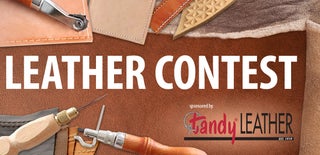Introduction: Leather Stropping Wheel
As a knifemaker I sharpen a lot of knives. The last step is called stropping and it involves dragging the blade lightly over a leather belt. About 50 strokes and the blade will become sharp like a razor. You've probably seen the old barbers using a leather strop when they work a straight razor. Having a motorized version of this would make life a little easier.
WARNING: Knives and knife sharpening is inherently dangerous. Adding a motor to something generally makes it less safe. Please use common sense, wear appropriate PPE and understand what you are doing.
I had some scrap leather sitting around and decided to make a stropping wheel that attaches to a common bench grinder.
If you find this of interest, I keep a comprehensive blog with all things knifemaking. There are many more great tutorials on my site: http://dcknives.blogspot.com
Step 1: Laying Out the Discs
Here I have some scrap 8/9 oz leather that had some tooling (stamping) done on the good side. The piece is about 14" square. If your leather is thinner, plan for making more circles.
You'll need enough leather to make a stack about 1" thick
I set the compass to 2" to make a 4" circle.
For reference I mark the spot where the compass point poked the leather.
One note here: A smaller wheel's surface speed is slower than a large wheel at the same RPM. Slower means cooler. This is why I am not making a giant wheel. Sometimes smaller is better. :-)
Step 2: Cutting Out the Discs
Some sharp scissors are used to cut the leather out. This can be a little tough, especially if the scissors are not sharp. A utility knife on a flat smooth surface will work too.
At this step we want to keep the circles fairly round, but it's not super critical as we'll shape them later.
Step 3: The Grand Glue-up
Heavy duty contact cement will bond most anything and works very well on rough leather. Liberally apply cement to one side of every disc. (in my case I made 6 discs).
Allow the cement to become tacky. Touch it with a piece of clean paper. If the paper sticks to the glue give it more time to dry.
Stick two discs together by pressing the glue sides together. Yes, glue side goes on glue side. Be careful to align the discs when sticking them together. Once this stuff sticks it's stuck.
You will now have three discs.
Apply contact cement to these and repeat the process until you have one thick disc.
I then pressed them with a few clamps and a piece of wood. This will ensure the disc is flat.
You should now have something that resembles a stack of pancakes. Note the edges are a little rough. We'll clean those up right away.
Step 4: Finishing the Wheel
With a disc sander, true up the edges a bit. Be sure to wear a mask or respirator when doing the the leather dust is nasty.
Find the center by measuring from the circle outsides and making an X.
Drill a pilot hole, say 1/8" all the way through the stack.
Now drill a larger hole to match your grinder or buffer. My little Delta has a 1/2" shaft, so I used a 1/2" drill bit.
Mount the wheel on the arbor and tighten the arbor nut. Give it a spin.
Step 5: Stropping a Blade
As stropping is usually that final step in creating a truly sharp edge you'll need to get your blade to a very fine "wire edge" by first using a stone or high grit sanding belt. Once the wire edge is attained, the stropping will remove the microscopic edge and create a very sharp and durable edge.
This is very important.
Always hold the knife where the wheel is moving away from you. Holding the knife where the wheel is coming towards you is likely to end badly.
In most bench grinders the bottom of the wheel moves away from you. Hold the knife at bottom of the wheel at an angle about 20° off the wheel. A light pass or two is all that is needed. Be sure to do both sides of the blade.

Participated in the
Leather Contest











